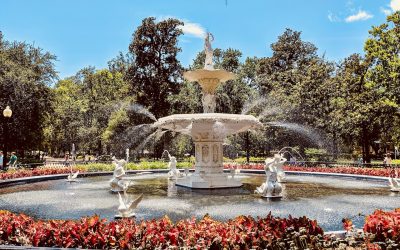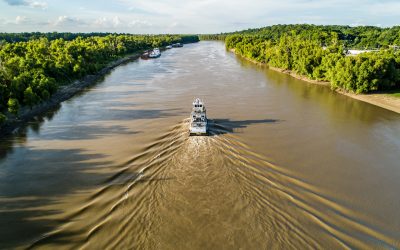Some people think that the shape of West Virginia resembles a leaping frog. Can you find West Virginia on a US map? Here’s a hint: the frog is leaping downward to the left and its nose is in the southwestern corner.
Just in case you can’t find it, West Virginia is bordered by five states: Ohio, Pennsylvania and Maryland to the north; Maryland and Virginia to the east; Virginia and Kentucky to the south; and Kentucky and Ohio to the west. The state’s western border is created by the Ohio River while its eastern border is created by the Appalachian Mountains.
It’s called the Mountain State for two reasons: It’s the only state in this country within the Appalachian Mountain region, and…follow the link to learn the second reason.
West Virginia has two geographical regions:
- The Appalachian Ridge and Valley Region: This area features the Appalachian and Blue Ridge Mountains, forests, caves, high mountain peaks, and canyons called water gaps.
- The Allegheny Plateau: This region has flat-topped hills, rounded peaks, and deep gorges. A wall of mountains called the Allegheny Front separates the state’s two regions.
Have you ever seen the Appalachian Mountains? They are some of the oldest on earth, having formed over 300 million years ago. What kind of animals do you think roamed the area at that time? The state is now home to 70 different types of animals ranging from Virginia big-eared bats to northern flying squirrels. Do you think they lived there 300 million years ago?
What really happened
- People have lived in what’s now West Virginia for at least 10,500 years. Thousands of years later, the Cherokee, Iroquis, Shawnee, and other Native American tribes lived in the area.
- Back in the 1600s, the British arrived in the area called Virginia, but the area was much larger than it is today. It included West Virginia, Virginia, Kentucky, and parts of North Carolina, Delaware, Pennsylvania and New York.
- In 1606, the Virginia Colony was established. The following year, Jamestown, the first British settlement in the Americas, was founded in what is now Virginia.
- In 1669, John Lederer became the first European to enter West Virginia after visiting the Blue Ridge Mountains. Two years later, explorers Thomas Batts and Robert Fallum discovered Kanawha Falls after they traveled into the Appalachian Mountains.
- The British government ruled the region. In 1730, it offered a thousand acres for free to each European family willing to move to the land that would become West Virginia. However, Native Americans were living on this land, so the tribes supported the French in a land war against the British (called the French and Indian War) from 1756 until 1763. The British won that war.
- In 1742, coal was first discovered in the area of West Virginia. The coal industry, however, didn’t really boom until the late 1800s. (In 2021, West Virginia was the second-largest coal producer in the nation after Wyoming, and supplied 14% percent of all the coal in this country.)
- John Brown was an abolitionist (someone who wanted to get rid of slavery). In 1859, he staged a famous raid on a town named Harpers Ferry, hoping to steal weapons to use in the fight against slavery. But, his raid failed.
- West Virginia split from Virginia in 1861, during the Civil War. It wanted to stay in the Union while Virginia wanted to become part of the Confederacy. It created its own government that was separate from Virginia. Lawmakers voted on three different state names: Kanawha (which honored a local Native American tribe), Allegheny and West Virginia.
- In 1863, West Virginia was admitted to the Union as the 35th It was the only state to be admitted under presidential proclamation (by President Abraham Lincoln).
- During the Great Railroad Strike of 1877, which started in West Virginia and spread to nearby states, more than 100 people died.
- In 1928, Minnie Buckingham Harper was appointed to fill her late husband’s seat. She was the first African American woman to serve in any legislature in the US.
Stuff you should know
- The state is known for its protected wetlands, timber (most of the state is covered by forest) and also salt. Many years ago, wild buffalo and deer licked the natural salt deposits while Native Americans and colonists gathered salt to preserve meat and cure butter.
- The New River is one of the few rivers in the world that flows south to north, which is opposite of most rivers. Why? It was formed before the mountains around it! Some believe it’s also one of the five oldest rivers in the world.
- Out of all 50 states, West Virginia has two panhandles extending to the north and east. A panhandle is a narrow strip of land that sticks out from a larger area, such as a state. (Think of the handle on a frying pan.) Other US states have just one panhandle. Can you name any of them? Some are mentioned at the end of this post!
Crazy, funny or just plain weird
- Many cities, towns or villages in the state are named after cities in other countries. For example, West Virginia is also home to places by the names of: Shanghai, Berlin, Cairo, Vienna, Calcutta, Geneva and Athens. Other unusually named towns include Man and, Mo’s favorite, Paw Paw.
- In 1776, residents of West Virginia petitioned the Congress to create a 14thstate called The petition was denied.
- Ramps are wild onions that grow here in the spring. They’re so popular that West Virginians host annual ramp festivals called the Feast of the Ramson.
- Cecil Underwood made history in 1956 when he became the state’s youngest governor at 34, then again in 1996 when he became the state’s oldest governor after being reelected at 74.
Tell me more
- The largest sycamore tree in the world lived in Webster Springs, West Virginia. It was estimated to be more than 500 years old until it fell in 2010. According to the Ohio Division of Natural Resources Division of Forestry, the tree stood more than 120 feet tall and its circumference (the distance around the tree) was 36 feet.
- There are 35 state parks in West Virginia. The largest is Watoga State Park, around Lake Watoga in Pocahontas C
- In 1896, the US Post Office began delivering mail for free to farms or homes in rural areas in West Virginia, which was the Postmaster’s home state.
Remember our question about panhandles from earlier in this post? Other states with panhandles include: Texas, Florida, Alabama, Connecticut, Idaho and Nebraska. There are more than just these states, though; look at the shape of states on a US map and see if you can find others.
Share your knowledge about West Virginia with other kids! If you live in this state or have ever visited, tell us something about the land, its people or history and we’ll post it along with your first name, age, and state you live in on Mo’s social media pages. Email your fun fact, tidbit or story to: info@adventuresofmo.com







